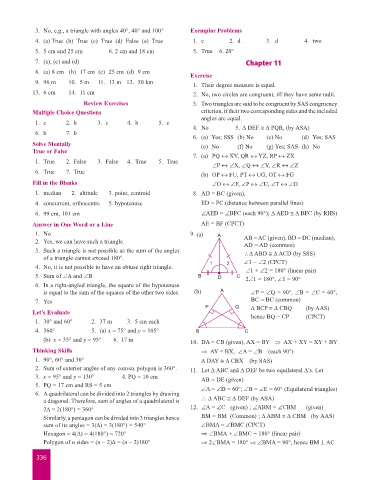Page 344 - Start Up Mathematics_7
P. 344
3. No, e.g., a triangle with angles 40°, 40° and 100° Exemplar Problems
4. (a) True (b) True (c) True (d) False (e) True 1. c 2. d 3. d 4. two
5. 5 cm and 25 cm 6. 2 cm and 18 cm 5. True 6. 20°
7. (a), (c) and (d) Chapter 11
8. (a) 8 cm (b) 17 cm (c) 25 cm (d) 9 cm
Exercise
9. 96 m 10. 5 m 11. 13 m 12. 50 km 1. Their degree measure is equal.
13. 6 cm 14. 11 cm 2. No, two circles are congruent, iff they have same radii.
Review Exercises 3. Two triangles are said to be congruent by SAS congruency
Multiple Choice Questions criterion, if their two corresponding sides and the included
angles are equal.
1. c 2. b 3. c 4. b 5. c
4. No 5. ∆ DEF ≅ ∆ PQR, (by ASA)
6. b 7. b
6. (a) Yes; SSS (b) No (c) No (d) Yes; SAS
Solve Mentally (e) No (f) No (g) Yes; SAS (h) No
True or False
7. (a) PQ XY, QR YZ, RP ZX
1. True 2. False 3. False 4. True 5. True
∠P ∠X, ∠Q ∠Y, ∠R ∠Z
6. True 7. True (b) OP FU, PT UG, OT FG
Fill in the Blanks ∠O ∠F, ∠P ∠U, ∠T ∠G
1. median 2. altitude 3. point, centroid 8. AD = BC (given),
4. concurrent, orthocentre 5. hypotenuse ED = FC (distance between parallel lines)
6. 99 cm, 101 cm ∠AED = ∠BFC (each 90°); ∆ AED ≅ ∆ BFC (by RHS)
Answer in One Word or a Line AE = BF (CPCT)
1. No 9. (a) A
2. Yes, we can have such a triangle. AB = AC (given), BD = DC (median),
AD = AD (common)
3. Such a triangle is not possible as the sum of the angles ∆ ABD ≅ ∆ ACD (by SSS)
of a triangle cannot exceed 180°. ∠1 = ∠2 (CPCT)
4. No, it is not possible to have an obtuse right triangle. 1 2 ∠1 + ∠2 = 180° (linear pair)
5. Sum of ∠A and ∠B B D C 2∠1 = 180°, ∠1 = 90°
6. In a right-angled triangle, the square of the hypotenuse
is equal to the sum of the squares of the other two sides. (b) A ∠P = ∠Q = 90°, ∠B = ∠C = 60°,
7. Yes BC = BC (common)
P Q ∆ BCP ≅ ∆ CBQ (by AAS)
Let’s Evaluate hence BQ = CP (CPCT)
1. 30° and 60° 2. 37 m 3. 5 cm each
4. 360° 5. (a) x = 75° and y = 105° B C
(b) x = 35° and y = 95° 6. 17 m 10. DA = CB (given), AX = BY ⇒ AX + XY = XY + BY
Thinking Skills ⇒ AY = BX, ∠A = ∠B (each 90°)
1. 90°, 60° and 30° ∆ DAY ≅ ∆ CBX (by SAS)
2. Sum of exterior angles of any convex polygon is 360°. 11. Let ∆ ABC and ∆ DEF be two equilateral ∆’s. Let
3. x = 95° and y = 130° 4. PQ = 10 cm AB = DE (given)
5. PQ = 17 cm and RS = 5 cm ∠A = ∠D = 60°; ∠B = ∠E = 60° (Equilateral triangles)
6. A quadrilateral can be divided into 2 triangles by drawing
a diagonal. Therefore, sum of angles of a quadrilateral is ∆ ABC ≅ ∆ DEF (by ASA)
2∆ = 2(180°) = 360° 12. ∠A = ∠C (given) ; ∠ABM = ∠CBM (given)
Similarly, a pentagon can be divided into 3 triangles hence BM = BM (Common) ; ∆ ABM ≅ ∆ CBM (by AAS)
sum of its angles = 3(∆) = 3(180°) = 540° ∠BMA = ∠BMC (CPCT)
Hexagon = 4(∆) = 4(180°) = 720° ⇒ ∠BMA + ∠BMC = 180° (linear pair)
Polygon of n sides = (n – 2)∆ = (n – 2)180° ⇒ 2∠BMA = 180° ⇒ ∠BMA = 90°, hence BM ⊥ AC
336

